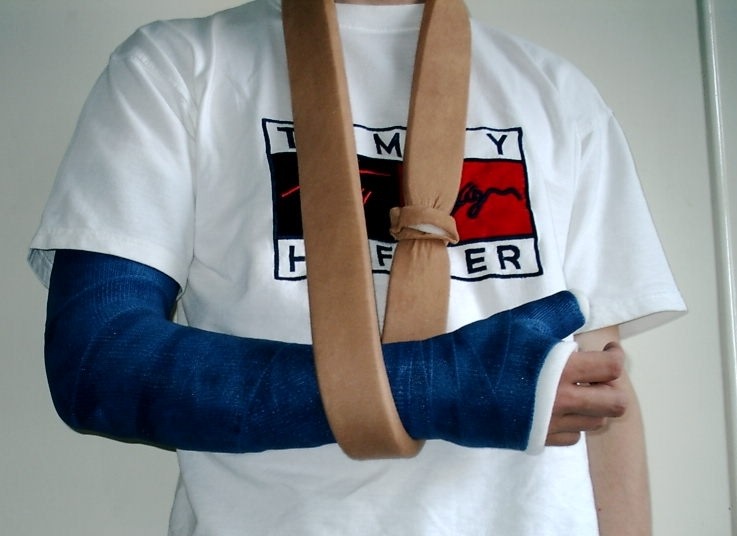4 Things You Should Know About Disabled Parking If You’re In A Sling

Having one of your arms in a sling can be a frustrating experience. You don’t have your full range of motion and often need to rely on others for help with day-to-day tasks. But there is one element that can be made a little bit easier.
Getting a handicap parking permit can give you access to more convenient parking places while you’re out and about. Here’s all the info you need to know about disabled parking in a sling.
1. There are many injuries that could require you to use a sling.
The use of a sling is required when a person needs to restrict movement in either one of their shoulders or arms. The sling works to immobilize the arm so that movement is minimal, allowing for injuries to mend. They’re made out of a strong fabric loop that hangs from your neck to support your arm. Your arm is bent at the elbow and rests in the sling. Some slings have a strap that also goes down your back to take the weight off of your neck; this strap is connected to the elbow side of the sling.
Slings are most often used for broken or dislocated shoulders, arms, or wrists or muscle strains or tears. There are also cases where people have operations (such as a rotator cuff surgery) and need to wear a sling for an extended period of time. There are other conditions that are a little bit more rare in terms of needing a sling (such as arthritis or stroke), but if you’ve been wondering whether getting a handicap parking permit when you have arthritis or another medical issue is a good idea, the answer is yes! Disabled parking in an arm cast or in a sling can be really useful – even if you don’t require the sling for a long period of time.

2. You can apply for a disabled parking placard.
Most people who need to use a sling won’t be using one permanently. As soon as their doctors clear them, they can stop using one. However, in the meantime, it can be helpful for a person to apply for a handicap parking permit. There is a fairly straightforward application process that you’ll need to fill out with your physician to get your placard. Your doctor can help you complete the medical certification portion of the application that tells your state’s Department of Motor Vehicles (DMV) that you could benefit from the use of a permit.
Your doctor will most likely recommend you for temporary disability parking. These placards are typically a different color than the blue permanent ones and can be used for a shorter period of time. Every state is different, but most states allow these permits to be used for around three months. They can be renewed a few times if you discover that you need to use your sling for a longer period of time. After submitting your completed application, the DMV will mail out your placard for you to use while you’re using your sling. It’s not likely that you’ll require the permanent use of a sling, but if you do, your doctor can help you request a permanent handicap parking permit.
3. There are a few things to keep in mind when driving with a sling.
The first thing to remember is that you probably shouldn’t be driving with your sling at all. It can be risky to drive with a sling because you don’t have full range of motion in your body and can’t grip the steering wheel or gears properly. You should ask yourself if you’re really capable of driving safely with your injury if you’re contemplating getting behind the wheel.
Second, always follow your doctor’s recommendations. If they say to keep your arm in a sling for four weeks, do so for that length of time and avoid driving. They’re the best judge of how capable you are to safely operate a car. While in need of a sling, ask a friend or family member to help with transportation or use the Uber or Lyft app to get a ride.
You never want to be in a position where you’re behind the wheel and are pulled over for a traffic violation or cause an accident. You can be cited if law enforcement determines that you were unable to drive safely because of your sling.

4. You can take advantage of handicap parking with a placard.
So, can a person with a broken arm park in a handicapped parking space? As long as you have your disabled parking permit, you definitely can. With your arm in a sling and your placard in hand, you can park in any designated handicapped parking places (usually indicated by posted signs, blue paint, or the International Symbol of Access of a wheelchair).
If you don’t need a van-accessible parking place, it’s common courtesy to save these spots for other disabled individuals who need them. However, your permit does mean that you can park in any handicapped parking places as long as your placard is valid. Just be sure to still follow all posted signs and parking restrictions.
If you find yourself in need of a sling and your doctor recommends a temporary disabled parking permit, make sure to fill out an application with the DMV. Then you can use your placard for the duration of time you require the sling, giving you immediate access to more convenient parking places to help make your life a little easier.
Featured image by Achim Raschka on Wikimedia Commons